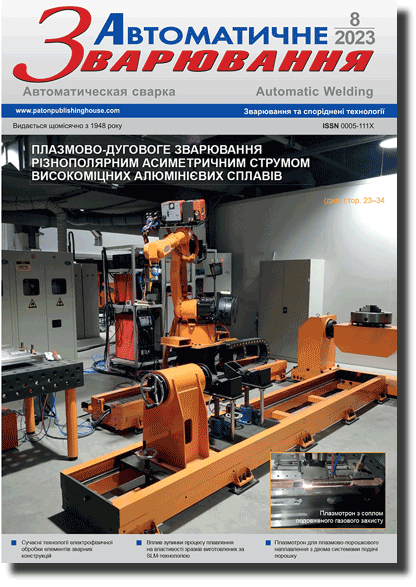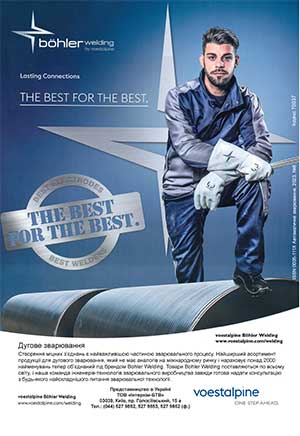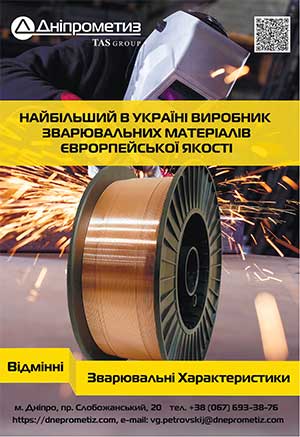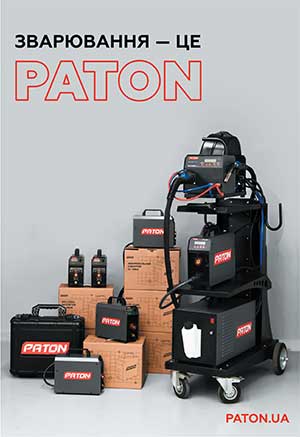| 2023 №08 (04) |
DOI of Article 10.37434/as2023.08.05 |
2023 №08 (06) |
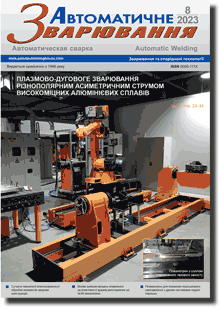
"Avtomatychne Zvaryuvannya" (Automatic Welding), #8, 2023, pp. 35-39
Influence of a stop in the process of melting on mechanical properties of specimens from the Co‒Cr‒Mo alloy made by SLM technology
S.V. Adzhamskyi1,2, G.A. Kononenko1,3, R.V. Podolskyi1,3,4
1LLC “Additive Laser Technologies of Ukraine”, 31 v Serhiy Podolynskyi Str., 49000, Dnipro, Ukraine2Institute of Transport Systems and Technologies of NASU, 5 Pisarzhevsky Str., 49000, Dnipro, Ukraine
3Iron and Steel Institute of Z.I. Nekrasov of NASU, Akademik Starodubov Sq., 49000, Dnipro, Ukraine
4Ukrainian State University of Science and Technologies, 4 Haharina Prosp., 49000, Dnipro, Ukrainea
In the modern manufacturing of parts of metal powder, the method of Selective Laser Melting (SLM) has become widespread. In Ukraine, the LLC “Additive Laser Technologies of Ukraine” is engaged in the development of equipment for manufacturing parts of metal powders by SLM technology. Nowadays, for this equipment, the relevant task is the development of a procedure for choosing the parameters of the process of melting metal powder, providing the necessary mechanical and service properties of parts. For the investigations, three experimental cylindrical specimens of Co‒Cr‒Mo alloy were made in the vertical direction for tensile test according to ISO 6892:2019 – with a diameter of the working zone of 5 mm, with a controlled stop at a height of 18 mm from the beginning of the working zone, the total length of which is 28 mm. As a result of the analysis of the values of mechanical properties, it was found that the ultimate strength of the experimental specimens of Co‒Cr‒Mo alloy made by SLM technology with a controlled stop during 24 h decreases compared to the specimens made without a controlled stop — by ~13 %, relative elongation – by ~1 % and reduction in area – by ~17 %. It was found that for the experimental specimens with a stop in the manufacturing process, the deviation from the average values was: for ultimate strength ~11 %, relative elongation ~62 % and reduction in area of ~21 %. This is predetermined by failure of one of the specimens at the place of a stop. The use of parts with a production defect (stop) should be significantly restricted respective to a probable significant softening and embrittlement of a product. 17 Ref., 1 Tabl., 4 Fig.
Keywords: selective laser melting, controlled stop, Co‒Cr‒Mo alloy, mechanical properties, density
Received: 16.06.2023
References
1. Mahoney, M.W. (1989) Superplatic Properties of Alloy 718. «Superalloy 718 Metallurgy and Applications». Eds. E.A. Loria, TMS, 391-405. https://doi.org/10.7449/1989/Superalloys_1989_391_4052. Adjamskiy, S., Kononenko, G., Podolskyi, R., Badyuk, S. (2022) Implementation Of Selective Laser Melting Technology In Ukraine. Kyiv, Naukova Dumka. 116p. [in Ukrainian]. https://doi.org/10.15407/978-966-00-1856-3
3. Conner, B.P., Manogharan, G.P., Martof A.N. et al. (2014) Making sense of 3-D printing; map of additive manufacturing products and services. Additive Manufacturing, 1-4, 64-74. https://doi.org/10.1016/j.addma.2014.08.005
4. Viňáš, J., Brezinová, J., Brezina, J., Maruschak, P.O. (2019) Structural and Mechanical Features of Laser-Welded Joints of Zinc-Coated Advanced Steel. Materials Science, 55. https://doi.org/10.1007/s11003-019-00250-x
5. Dudda, W. (2019) Influence of High Temperatures on the Mechanical Characteristics of 26H2MF and ST12T STEELS. Materials Science, 55. https://doi.org/10.1007/s11003-019-00322-y
6. Frazier ,W.E. (2014) Metal additive manufacturing: a review. Journal of Materials Engineering and performance, 23, 6, 1917-1928. https://doi.org/10.1007/s11665-014-0958-z
7. A.I. (1981) Strengthening of parts by laser beam. Kyiv, Tekhnika [in Russian].
8. Kruth, J.-P., Leu, M.-C., Nakagawa, T. (1998) Progress in additive manufacturing and rapid prototyping, CIRP Ann.- Manuf. Technol., 47, 2, 525-540. https://doi.org/10.1016/S0007-8506(07)63240-5
9. Kamath, C. (2016) Data mining and statistical inference in selective laser melting. Int J. Adv. Manuf. Technol., 86, 1659-1677. https://doi.org/10.1007/s00170-015-8289-2
10. Adzhamskyi, S.V., Kononenko, G.A., Podolskyi, R.V. (2021) Influence of parameters of SLM-process on formation of boundary area of parts from heat-resistant nickel alloy Inconel 718. Kosmichna Nauka i Tekhnologiya, 27(6), 105-114. https://doi.org/10.15407/knit2021.06.105
11. Williams, C.B., Mistree, F., Rosen, D.W. (2005) Towards the design of a layerbased additive manufacturing process for the realization of metal parts of designed mesostructured. Proc. 16th Solid Free. Fabr. Symp., 217-230. https://doi.org/10.1115/DETC2005-84832
12. Loh, L.-E., Chua C.-K., Yeong W.-Y. et al. (2015) Numerical investigation and an effective modelling on the Selective Laser Melting (SLM) process with aluminium alloy 6061. Int. J. Heat Mass Transf., 80, 288-300. https://doi.org/10.1016/j.ijheatmasstransfer.2014.09.014
13. Adzhamskyi, S.V., Kononenko, G.A., Podolskyi, R.V. (2020) Influence of technological parameters of SLM-process on porosity of metal products. The Paton Welding J., 10, 13-18. https://doi.org/10.37434/as2020.10.03
14. (2002) ASM Metals HandBook V.2. Properties and Selection: Nonferrous Alloys and Special-Purpose Materials. ASM International.
15. Callister, W.D., Callister, Jr W.D. (2000) Fundamentals of Materials Science and Engineering: An Interactive: Text, 5th Edition. Wiley. https://doi.org/10.1108/acmm.2000.12847aae.001
16. Adjamsky, S.V., Sazanishvili, Z.V., Tkachov, Y.V. et al. (2021) Influence of the Time Interval between the Deposition of Layers by the SLM Technology on the Structure and Properties of Inconel 718 Alloy. Mater Sci 57, 9-16. https://doi.org/10.1007/s11003-021-00508-3
17. Adjamskiy, S., Kononenko, G., Podolskyi, R., Baduk, S. (2022) Studying the Influence of Orientation and Layer Thickness on the Physico-Mechanical Properties of Co- Cr-Mo Alloy Manufactured by the SLM Method. Science and Innovation, 18(5), 85-94. https://doi.org/10.15407/scine18.05.085
Advertising in this issue:
The cost of subscription/purchase order journals or individual articles
| Journal/Currency | Annual Set | 1 issue printed |
1 issue |
one article |
| TPWJ/USD | 384 $ | 32 $ | 26 $ | 13 $ |
| TPWJ/EUR | 348 € | 29 € | 24 € | 12 € |
| TPWJ/UAH | 7200 UAH | 600 UAH | 600 UAH | 280 UAH |
| AS/UAH | 1800 UAH | 300 UAH | 300 UAH | 150 UAH |
| AS/USD | 192 $ | 32 $ | 26 $ | 13 $ |
| AS/EUR | 180 € | 30 € | 25 € | 12 € |
| SEM/UAH | 1200 UAH | 300 UAH | 300 UAH | 150 UAH |
| SEM/USD | 128 $ | 32 $ | 26 $ | 13 $ |
| SEM/EUR | 120 € | 30 € | 25 € | 12 € |
| TDNK/UAH | 1200 UAH | 300 UAH | 300 UAH | 150 UAH |
| TDNK/USD | 128 $ | 32 $ | 26 $ | 13 $ |
| TDNK/EUR | 120 € | 30 € | 25 € | 15 € |
AS = «Automatic Welding» - 6 issues per year;
TPWJ = «PATON WELDING JOURNAL» - 12 issues per year;
SEM = «Electrometallurgy Today» - 4 issues per year;
TDNK = «Technical Diagnostics and Non-Destructive Testing» - 4 issues per year.





